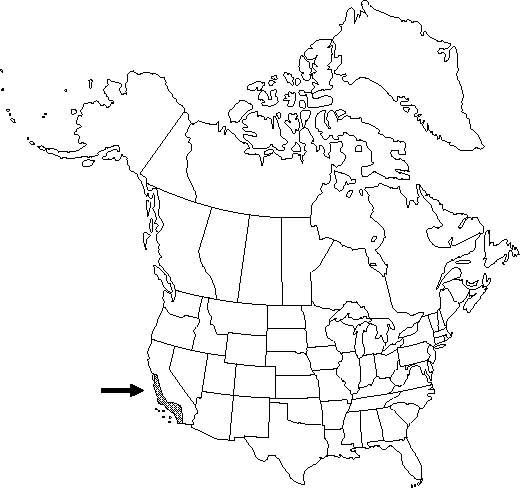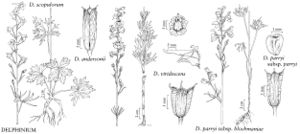Difference between revisions of "Delphinium parryi subsp. parryi"
FNA>Volume Importer |
imported>Volume Importer |
||
| (2 intermediate revisions by 2 users not shown) | |||
| Line 56: | Line 56: | ||
|publication year= | |publication year= | ||
|special status=Illustrated | |special status=Illustrated | ||
| − | |source xml=https:// | + | |source xml=https://bitbucket.org/aafc-mbb/fna-data-curation/src/2e0870ddd59836b60bcf96646a41e87ea5a5943a/coarse_grained_fna_xml/V3/V3_1127.xml |
|genus=Delphinium | |genus=Delphinium | ||
|section=Delphinium sect. Diedropetala | |section=Delphinium sect. Diedropetala | ||
Latest revision as of 21:46, 5 November 2020
Roots 5-20 cm. Stems (35-)60-90(-110) cm. Leaves: basal leaves usually absent at anthesis; cauline leaves with ultimate lobes 7-27, width 1-6 mm. Inflorescences: bracteoles 3-7 mm. Flowers: sepals usually spreading, lateral sepals 9-15 mm, spurs 8-15 mm; lower petal blades 3-8 mm. 2n = 16.
Phenology: Flowering spring.
Habitat: Locally abundant in oak woodland, chaparral
Elevation: 200-1700 m
Distribution

Calif., Mexico (Baja California).
Discussion
Two morphotypes may be recognized in Delphinium parryi subsp. parryi. That corresponding to the type specimen of subsp. parryi has larger flowers (especially lower petal blades), less abundant pubescence, and somewhat more coarsely dissected leaves; it is usually found in woodlands or relatively moist chaparral. The second morphotype, in its extreme represented by the type specimen of D. parryi var. seditiosum, has smaller flowers, more pubescence, and more finely dissected leaves and is usually found in chaparral and, less often, in dry woodlands. It may occur sporadically throughout the range of D. parryi subsp. parryi, although it is most common north of the Transverse Ranges. Hybrids with D. cardinale have been named D. ×inflexum. Hybrids are also known with D. gypsophilum subsp. parviflorum, D. hesperium subsp. pallescens, D. umbraculorum, and D. variegatum.
Delphinium parryi subsp. parryi may be confused with the blue-flowered phases of D. hesperium; see discussion under that species for distinguishing features.
Selected References
None.
